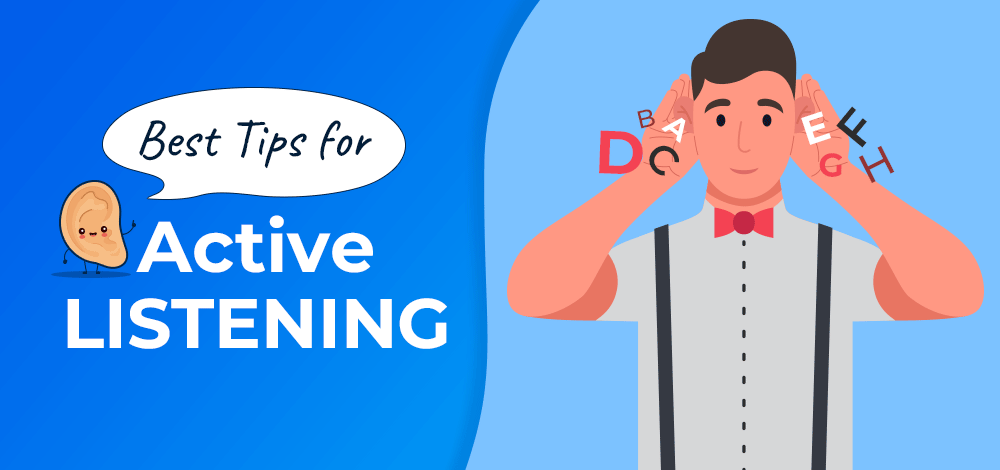Have you ever wondered why people have favorites regarding interviewers, hosts, and even specific celebrities? For example, among the different types of celebrity show hosts appearing on prime-time television, some, like Jimmy Fallon, are widely liked. The reason for that is his charm, for sure, but so are many other hosts. So, what sets him apart?
Much of it has to do with how he communicates with his guests, engaging with them fully with their expressions and attention. Indeed, the American talk-show host has excellent skills to make people feel comfortable, and he achieves it through his good active listening skill.
You do not have to take a masterclass in any new technique to enrapture your audience- simply honing your listening ability should help. Here, learn the best tips to try for that.

What Do You Mean By Active Listening?
Statistics show that most of the time, i.e., 75%, people are forgetful, preoccupied, or distracted during conversations. Thereby, it affects the overall information intake on both sides, causes miscommunication, and builds mistrust.
On that note, active listening as a communication skill is essential to enhance. This approach involves when a person is focusing entirely on the person they are conversing with, listening to their words instead of only hearing them superficially. To elaborate, when they center on understanding the intent and meaning behind someone’s words, that is a mark of active communication.
In the professional context, having good communication skills is crucial for the best outcome. Statistically, 28% of employees mention poor communication as the main reason they cannot deliver timely work. One of the most prominent examples of this is not properly listening to the other person, and that is something you should work on.
Tips to Improve Active Listening
Can you improve your ability to listen actively during social or professional interactions? Indeed, this is something that people can work on over time, and with some techniques, you can manage active listening in no time. Here are some suggestions.
1. Avoid Distractions Around You
One of the most significant issues many people face during conversations is distractions. For example, in an office space, one might have a lot of things to handle, like signing documents, browsing folders, doing research, etc. At that time, if someone is speaking to the person, it is tough to reply will proper etiquette and nicety.
The signs of stress can appear on your expression, like scrunching on the eyebrows or distracted eye movements. That also gives off a negative vibe, as if the person is not interested in listening, which can put off many people.
The best solution for this? Keep away from distractions as much as possible. Certainly, sudden work can come up that might disturb a conversation. But you can take the initiative to avoid intentional distractions, like using your phone too much.
2. Make Silence Your Friend
During conversations, many people have the misconception that silence in between words shows that you are not paying attention. Therefore, they start speaking when there are silent moments in the conversation to avoid it.
However, that does more harm than good sometimes, like during deeper or emotional conversations. For example, if someone is sharing their sadness and there is a moment of silence, speaking at that time can harm the flow of dialogue and make them feel unheard.
Instead, let the moment stay. The speaker may need that time to manage their emotions or settle their mind before continuing onward. So, give them some quiet time and keep an attentive posture to show that they can take their time nonverbally.
3. Ask Questions and Make Affirmative Sounds
Another tip you should follow in showing that you actively listen through certain sounds. Examples include humming to show that you agree or sucking in your breath in surprise.
Also, it would be best if you asked questions occasionally relevant to where the story is at the time. For example, “Oh my God, she did not! Then what happened?” Such interjections show that you are listening actively. However, do this in moderation.
4. Read People’s Body Language
Have you seen the various videos on social media where people study the body language of others to understand their thought processes at a time? In fact, the art of understanding body language is practiced in many professions, like crime investigation. For example, the FBI has professional body language experts who study people’s non-verbal cues during interrogations.
While you can avoid adopting a similar interrogative technique in your day-to-day conversations, learning to read body language is a skill worth practicing. In terms of active listening, will also help since you will know how to read the unspoken signals of the person speaking to you.
Plus, you can incorporate similar techniques to seem more attentive as well. For example, please keep an open posture, like relaxing your body and facing them directly. Maintain proper eye contact and even lean in slightly. Avoid showing signs of discomfort like sitting ramrod straight, rolling your eyes, or yawning.
5. Do Not Jump into the Conversation
As hinted previously, it is best not to jump into conversations until it is time for you to speak. That will come across as rude and further antagonize the person talking to you.
So, an important thing to avoid is adding additional comments to the speaker’s words, even if you need to make a factual correction. The speaker can get disoriented with the train of speech if a person interrupts them- so avoid that. If you need to add anything urgently or ask for any clarification, wait for the person to finish their point.
6. Adopt a Student Mindset
One psychological trick you can adopt is keeping a student-like mindset during communications. If you go into interactions with the approach of what you can learn from them, you will focus more on their words entirely.
An essential trait of an excellent active listener is someone who listens to the points of the person they are talking to first. Then, they respond accordingly instead of adding unnecessary information.
7. Avoid Keeping Judgments
Do you know what makes Oprah Winfrey one of the best interviewers in modern history? The veteran talk show host speaks to people with complete focus and compassion, whatever their story may be. No matter who her guest is or her personal feelings towards them or their beliefs, the host does not show obvious negative signs.
That is something that you should emulate to be an active listener. Keep judgemental facial expressions to a minimum, like raising one eyebrow, scrunching your face, or other negative facial expressions. Instead, listen to the speaker openly and without judgment, making them feel more comfortable speaking.
8. Maintain Proper Eye Contact
One place where many people have issues during conversations is avoiding eye contact with the speaker while talking to them.
Suppose you are looking around too much while someone is speaking to you; that gives off the impression that you are not paying attention. Then, they have to repeat themselves to catch your attention, which will leave a wrong impression in their mind. In fact, statistics show that 85% of people find repeating what they said very bothersome in conversations.
With proper eye contact, you can avoid this issue entirely. If you find it challenging to do this naturally, use the tactic of staring at one eye for around 5 seconds and then around 5 seconds on the other. Switch and repeat. Also, you can move your eyes to the side or above in some cases for a split second if your eyes need a distraction, but avoid looking down. Also, keep an open posture to avoid looking too closed off.
9. Do Not Give Unsolicited Advice
One of the crucial tips to follow for being a good active listener is to avoid speaking when the other person is still talking. In this context, a major faux pas is to give your suggestions unless asking.
Indeed, do not use a strong voice or challenging words even if, in the context of the conversation, the speaker is in the wrong. For example, telling someone to suck it up and apologize will come across as highly disrespectful or discourteous, depending on how they take it. Instead, softly acknowledge their hurt and then suggest a resolution.
For example, “I understand your side and why you are upset. But, if I could give a suggestion,…” and so on.
10. Paraphrase the Entire Conversation and Summarise
One tactic you should try to be an active listener is to summarise whatever the speaker said to you in short and repeat it for verification.
This helps in two ways. Indeed, it shows the other person in the conversation that you were paying attention. Also, in case you missed the point or heard something wrong, they can jump in and correct you.
Conclusion
All things considered, focusing on the speaker’s words and taking in the complete information helps ensure top-notch communication. It would help if you practiced all of the tips mentioned in your regular conversations to grow into a great communicator slowly. Indeed, use both your non-verbal and verbal cues liberally, becoming a naturally good listener over time.




